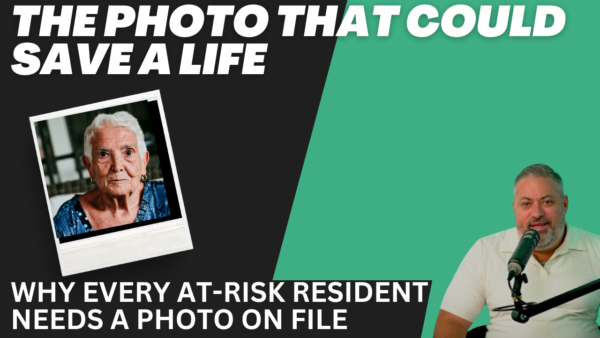
The Photo That Could Save a Life: Why Every At-Risk Resident Needs One on File
When a resident with cognitive impairment, dementia, or a history of wandering goes missing from an assisted living facility, every second counts. Elopement is a life-threatening emergency, and the faster law enforcement can identify and locate the resident, the higher the chances of a safe return.
This is why Florida’s 59A-36.007(7)(a), F.A.C. mandates that facilities maintain a photo identification of every resident assessed at risk for elopement. But compliance with the law is just the beginning—having an up-to-date, easily accessible photo could be the difference between life and death.
Step One: Assessing Residents for Elopement Risk
Florida law requires that all assisted living facility residents be assessed for elopement risk within 30 days of admission. According to 59A-36.007(7)(a), F.A.C.:
“All residents must be assessed for risk of elopement by a health care provider or a mental health care provider within 30 calendar days of being admitted to a facility. If the resident has had a health assessment performed prior to admission pursuant to paragraph 59A-36.006(2)(a), F.A.C., this requirement is satisfied.”
This assessment helps facilities identify which residents are at risk and require additional safety precautions—including having a photo identification on file.
Why Photos Are Critical in an Elopement Emergency
Once a resident is deemed at risk for elopement, Florida law requires the facility to have a current photo on file that is accessible to all facility staff and law enforcement when necessary. Per 59A-36.007(7)(a)(2), F.A.C.:
“The facility must have a photo identification of at-risk residents on file that is accessible to all facility staff and law enforcement as necessary. The facility’s file must contain the resident’s photo identification upon admission or upon being assessed at risk for elopement subsequent to admission. The photo identification may be provided by the facility, the resident, or the resident’s representative.”
Without an updated, accessible photo:
![]() Law enforcement has no way to visually confirm who they’re looking for.
Law enforcement has no way to visually confirm who they’re looking for.
![]() Search efforts are delayed while staff scramble to find or take a picture.
Search efforts are delayed while staff scramble to find or take a picture.
![]() Every second lost increases the chances of harm—traffic accidents, exposure, or getting lost.
Every second lost increases the chances of harm—traffic accidents, exposure, or getting lost.
A recent photo allows emergency responders to quickly distribute alerts, notify the public, and identify the missing resident if spotted. Time is everything.
Best Practices: How to Stay Prepared
To go beyond compliance and ensure resident safety, assisted living facilities should implement these best practices:
![]() Take a photo of every new resident upon admission—before assessing elopement risk. This ensures a current image is always on file, even if the assessment occurs later.
Take a photo of every new resident upon admission—before assessing elopement risk. This ensures a current image is always on file, even if the assessment occurs later.
![]() Store the photo in an easily accessible location, so ALL staff can retrieve it quickly in case of an emergency.
Store the photo in an easily accessible location, so ALL staff can retrieve it quickly in case of an emergency.
![]() Regularly update resident photos—every six months or sooner if their appearance changes significantly (weight loss, haircut, facial hair, glasses, etc.).
Regularly update resident photos—every six months or sooner if their appearance changes significantly (weight loss, haircut, facial hair, glasses, etc.).
![]() Train staff on elopement procedures, including the importance of having a printed or digital photo ready to provide to law enforcement immediately.
Train staff on elopement procedures, including the importance of having a printed or digital photo ready to provide to law enforcement immediately.
![]() Ensure compliance by checking photo records during routine audits. Make sure every at-risk resident has a valid, up-to-date photo in their file.
Ensure compliance by checking photo records during routine audits. Make sure every at-risk resident has a valid, up-to-date photo in their file.
Final Thoughts
A simple photograph can be one of the most powerful tools in preventing tragedy when an at-risk resident elopes. Florida law mandates it—but true safety comes from a proactive approach. Assisted living facilities must make resident photo documentation a priority from the moment they are admitted.
Don’t wait until it’s too late. Take the photo. Save a life.
For expert guidance on assisted living compliance, training, and operations, ALF BOSS is here to help.